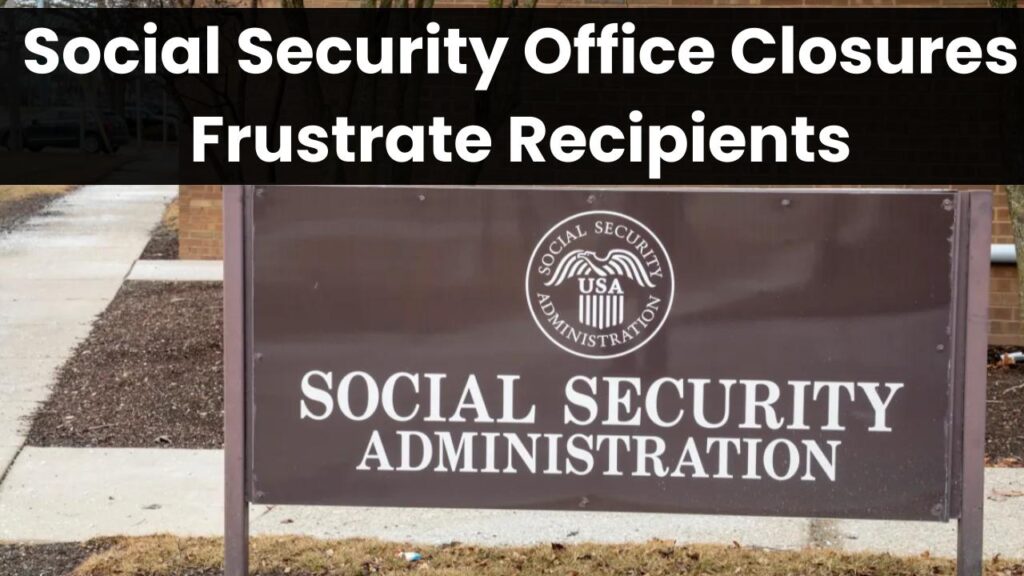
The phrase “Forced to Visit in Person? Social Security Office Closures Leave Recipients Frustrated” isn’t just a headline; it’s a growing reality for millions of Americans relying on Social Security. As policy changes roll out and local field offices close, many find themselves navigating a maze of requirements, delays, and new barriers to accessing their benefits.
The Social Security Administration (SSA) is implementing stricter in-person identity verification requirements while simultaneously closing dozens of field offices across the country. This combination has led to increased stress, especially for elderly and disabled beneficiaries who depend heavily on these services.
Also Check: Oscar Winner Arrested After West Bank Violence — The Shocking Story Behind the Headlines
Why Are Social Security Offices Closing?
The SSA has announced plans to close up to 47 field offices, citing budgetary pressures and a nationwide push for digital transformation. These moves are part of a broader government efficiency campaign led by the Department of Government Efficiency (DOGE) and supported by private sector figures such as Elon Musk.
However, while digital tools can make services faster and cheaper, they are not always accessible to everyone. For the nearly 70 million Americans who receive Social Security benefits, the closure of physical offices can make accessing services much harder, especially for older adults or people in rural areas without reliable internet.
“We understand the importance of digital services, but they should not come at the cost of accessibility and human support,” said a spokesperson from the National Committee to Preserve Social Security and Medicare.
New Identity Verification Requirements
Starting March 31, 2025, the SSA will enforce stricter in-person identity verification procedures. These new rules are designed to combat identity theft and fraud, which cost the SSA billions each year. However, critics argue that the timing couldn’t be worse.
With fewer offices and a reduced workforce, people are now required to make appointments or wait in long lines just to verify their identity — something many previously did online or by phone. This policy applies to:
- New benefit applicants
- People updating banking or direct deposit information
- Those flagged for suspicious activity
How to Navigate the Changes
If you’re one of the many affected by these changes, here are a few steps to prepare:
Step 1: Try Online Services First
Before heading to an SSA office, check their official website to see if your request can be handled online. Many services like benefit estimations, status checks, and even some appeals are available digitally.
Step 2: Schedule an Appointment
Due to high demand, most SSA offices now operate by appointment only. Use the SSA Office Locator to find the nearest office and schedule a time. Walk-ins may face wait times of several hours.
Step 3: Bring the Right Documents
For identity verification, make sure to bring:
- Government-issued photo ID (e.g., driver’s license or passport)
- Proof of Social Security number
- Bank information if updating direct deposit
- Any notices or letters received from the SSA
Step 4: Be Prepared for Delays
Because of office closures and reduced staffing, some users report waiting weeks for appointments or receiving callbacks. Plan accordingly and follow up regularly.
Step 5: Explore Local Support Services
Community organizations, local government agencies, and nonprofits often provide help navigating Social Security issues. These services can assist with paperwork, appointments, and online access.
- Contact your local Area Agency on Aging
- Visit a community help center or legal aid clinic
- Call 211 for social service assistance
Also Check: Earn ₹20,000 Every Month! Invest in This Unique Scheme – Learn How to Benefit
Impact on Vulnerable Populations
The new policies disproportionately affect:
- Seniors who may not be tech-savvy
- Disabled individuals who rely on local services
- Low-income families without internet access
- People in rural or underserved areas
Many advocacy groups, including AARP, have voiced concerns, urging the SSA to implement hybrid options and maintain at least a minimum level of in-person support.
“No one should have to choose between losing their benefits and waiting three hours at a distant office,” said an AARP representative.
What Lawmakers Are Saying
Lawmakers from both sides of the aisle are taking notice. Several Congressional hearings are scheduled to review the SSA’s recent policy shifts. Concerns include:
- Whether the closures violate federal service mandates
- How much fraud these changes actually prevent
- If the cost savings are worth the human toll
In the meantime, some states are stepping in to provide supplementary support or information hotlines to assist residents.
Government Efficiency vs. Public Access
This situation reflects a broader trend in public policy where cost-cutting and digital innovation are prioritized over universal accessibility. While fraud prevention and modernization are important, public service institutions like the SSA serve a vital role in the lives of everyday Americans.
Experts warn that “digital by default” approaches can backfire when they neglect those without adequate digital literacy or access.
“This is a test case for how the government balances modernization with its duty to serve all citizens,” said Dr. Linda Greenfield, a public policy analyst at the Brookings Institution.
(FAQs)
1. Why is the SSA requiring in-person visits now?
The SSA says the new policy combats fraud and improves data security, especially for high-risk changes like banking information updates.
2. Can I still do anything online?
Yes. Many SSA services are still available online at ssa.gov, including benefit calculators, appeals, and some change requests.
3. What if I can’t travel to an SSA office?
Some offices may offer limited accommodations for those who are homebound or disabled. Contact the SSA directly to request assistance.
Also Check: Grant Ellis Chooses His Final Rose — But Here’s Why the Wedding May Not Happen Anytime Soon!










